3rd century BCE

- Aristarchus of Samos (c. 310 – c. 230 BCE) was the first known originator of a heliocentric (solar) system. Such a system was formulated again some 18 centuries later by Nicolaus Copernicus (1473–1543). [7] [8]
Historians and sociologists have remarked the occurrence, in science, of "multiple independent discovery". Robert K. Merton defined such "multiples" as instances in which similar discoveries are made by scientists working independently of each other. [1] "Sometimes", writes Merton, "the discoveries are simultaneous or almost so; sometimes a scientist will make a new discovery which, unknown to him, somebody else has made years before." [2]
Commonly cited examples of multiple independent discovery are the 17th-century independent formulation of calculus by Isaac Newton, Gottfried Wilhelm Leibniz and others, described by A. Rupert Hall; [3] the 18th-century discovery of oxygen by Carl Wilhelm Scheele, Joseph Priestley, Antoine Lavoisier and others; and the theory of the evolution of species, independently advanced in the 19th century by Charles Darwin and Alfred Russel Wallace.
Multiple independent discovery, however, is not limited to such famous historic instances. Merton believed that it is multiple discoveries, rather than unique ones, that represent the common pattern in science. [4]
Merton contrasted a "multiple" with a "singleton"—a discovery that has been made uniquely by a single scientist or group of scientists working together. [5]
A distinction is drawn between a discovery and an invention, as discussed for example by Bolesław Prus. [6] However, discoveries and inventions are inextricably related, in that discoveries lead to inventions, and inventions facilitate discoveries; and since the same phenomenon of multiplicity occurs in relation to both discoveries and inventions, this article lists both multiple discoveries and multiple inventions.

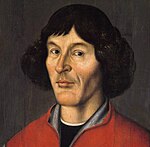













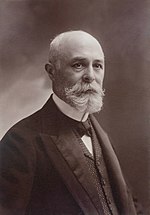


















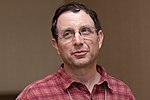









"When the time is ripe for certain things, these things appear in different places in the manner of violets coming to light in early spring."
— Farkas Bolyai to his son János Bolyai, urging him to claim the invention of non-Euclidean geometry without delay,
quoted in Ming Li and Paul Vitanyi, An introduction to Kolmogorov Complexity and Its Applications, 1st ed., 1993, p. 83.
"[Y]ou do not [make a discovery] until a background knowledge is built up to a place where it's almost impossible not to see the new thing, and it often happens that the new step is done contemporaneously in two different places in the world, independently."
— a physicist Nobel laureate interviewed by Harriet Zuckerman, in Scientific Elite: Nobel Laureates in the United States, 1977, p. 204.
"[A] man can no more be completely original ... than a tree can grow out of air."
I never had an idea in my life. My so-called inventions already existed in the environment – I took them out. I've created nothing. Nobody does. There's no such thing as an idea being brain-born; everything comes from the outside.

Albert Einstein was a German-born theoretical physicist who is widely held to be one of the greatest and most influential scientists of all time. Best known for developing the theory of relativity, Einstein also made important contributions to quantum mechanics, and was thus a central figure in the revolutionary reshaping of the scientific understanding of nature that modern physics accomplished in the first decades of the twentieth century. His mass–energy equivalence formula E = mc2, which arises from relativity theory, has been called "the world's most famous equation". He received the 1921 Nobel Prize in Physics "for his services to theoretical physics, and especially for his discovery of the law of the photoelectric effect", a pivotal step in the development of quantum theory. His work is also known for its influence on the philosophy of science.

Physics is a branch of science whose primary objects of study are matter and energy. Discoveries of physics find applications throughout the natural sciences and in technology. Historically, physics emerged from the scientific revolution of the 17th century, grew rapidly in the 19th century, then was transformed by a series of discoveries in the 20th century. Physics today may be divided loosely into classical physics and modern physics.

Murray Gell-Mann was an American theoretical physicist who played a preeminent role in the development of the theory of elementary particles. Gell-Mann introduced the concept of quarks as the fundamental building blocks of the strongly interacting particles, and the renormalization group as a foundational element of quantum field theory and statistical mechanics. He played key roles in developing the concept of chirality in the theory of the weak interactions and spontaneous chiral symmetry breaking in the strong interactions, which controls the physics of the light mesons. In the 1970s he was a co-inventor of quantum chromodynamics (QCD) which explains the confinement of quarks in mesons and baryons and forms a large part of the Standard Model of elementary particles and forces.

Paul Adrien Maurice Dirac was an English mathematical and theoretical physicist who is considered to be one of the founders of quantum mechanics and quantum electrodynamics. He is credited with laying the foundations of quantum field theory. He was the Lucasian Professor of Mathematics at the University of Cambridge, a professor of physics at Florida State University and the University of Miami, and a 1933 Nobel Prize in Physics recipient.
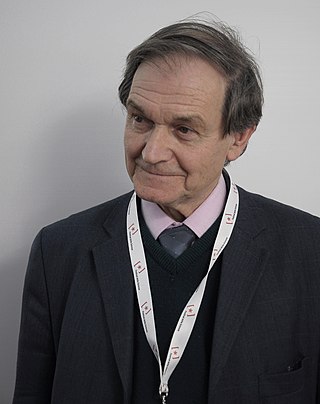
Sir Roger Penrose is a British mathematician, mathematical physicist, philosopher of science and Nobel Laureate in Physics. He is Emeritus Rouse Ball Professor of Mathematics in the University of Oxford, an emeritus fellow of Wadham College, Oxford, and an honorary fellow of St John's College, Cambridge, and University College London.

In physics, gravity (from Latin gravitas 'weight') is a fundamental interaction which causes mutual attraction between all things that have mass. Gravity is, by far, the weakest of the four fundamental interactions, approximately 1038 times weaker than the strong interaction, 1036 times weaker than the electromagnetic force and 1029 times weaker than the weak interaction. As a result, it has no significant influence at the level of subatomic particles. However, gravity is the most significant interaction between objects at the macroscopic scale, and it determines the motion of planets, stars, galaxies, and even light.

Jules Henri Poincaré was a French mathematician, theoretical physicist, engineer, and philosopher of science. He is often described as a polymath, and in mathematics as "The Last Universalist", since he excelled in all fields of the discipline as it existed during his lifetime. Due to his scientific success, influence and his discoveries, he has been deemed "the philosopher par excellence of modern science."

Max Born was a German-British physicist and mathematician who was instrumental in the development of quantum mechanics. He also made contributions to solid-state physics and optics and supervised the work of a number of notable physicists in the 1920s and 1930s. Born was awarded the 1954 Nobel Prize in Physics for his "fundamental research in quantum mechanics, especially in the statistical interpretation of the wave function".

Lev Davidovich Landau was a Soviet physicist who made fundamental contributions to many areas of theoretical physics. He was also involved in the design of the Soviet atomic bomb.

Georges Henri Joseph Édouard Lemaître was a Belgian Catholic priest, theoretical physicist, mathematician, astronomer, and professor of physics at the Catholic University of Louvain. He was the first to theorize that the recession of nearby galaxies can be explained by an expanding universe, which was observationally confirmed soon afterwards by Edwin Hubble. He first derived "Hubble's law", now called the Hubble–Lemaître law by the IAU, and published the first estimation of the Hubble constant in 1927, two years before Hubble's article. Lemaître also proposed the "Big Bang theory" of the origin of the universe, calling it the "hypothesis of the primeval atom", and later calling it "the beginning of the world".

Kip Stephen Thorne is an American theoretical physicist known for his contributions in gravitational physics and astrophysics. Along with Rainer Weiss and Barry C. Barish, he was awarded the 2017 Nobel Prize in Physics for his contributions to the LIGO detector and the observation of gravitational waves.

The annus mirabilis papers are the four papers that Albert Einstein published in Annalen der Physik, a scientific journal, in 1905. These four papers were major contributions to the foundation of modern physics. They revolutionized science's understanding of the fundamental concepts of space, time, mass, and energy. Because Einstein published all four of these papers in a single year, 1905 is called his annus mirabilis.

Marshall Nicholas Rosenbluth was an American plasma physicist and member of the National Academy of Sciences, and member of the American Philosophical Society. In 1997 he was awarded the National Medal of Science for discoveries in controlled thermonuclear fusion, contributions to plasma physics, and work in computational statistical mechanics. He was also a recipient of the E.O. Lawrence Prize (1964), the Albert Einstein Award (1967), the James Clerk Maxwell Prize for Plasma Physics (1976), the Enrico Fermi Award (1985), and the Hannes Alfvén Prize (2002).
This timeline lists significant discoveries in physics and the laws of nature, including experimental discoveries, theoretical proposals that were confirmed experimentally, and theories that have significantly influenced current thinking in modern physics. Such discoveries are often a multi-step, multi-person process. Multiple discovery sometimes occurs when multiple research groups discover the same phenomenon at about the same time, and scientific priority is often disputed. The listings below include some of the most significant people and ideas by date of publication or experiment.
In science, priority is the credit given to the individual or group of individuals who first made the discovery or propose the theory. Fame and honours usually go to the first person or group to publish a new finding, even if several researchers arrived at the same conclusion independently and at the same time. Thus, between two or more independent discoverers, the first to publish is the legitimate winner. Hence, the tradition is often referred to as the priority rule, the procedure of which is nicely summed up in a phrase "publish or perish", because there are no second prizes. In a way, the race to be first inspires risk-taking that can lead to scientific breakthroughs which is beneficial to the society. On the other hand, it can create unhealthy competition and incentives to publish low-quality findings, which can lead to an unreliable published literature and harm scientific progress.
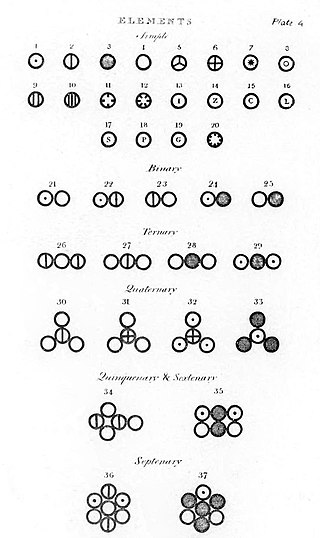
This timeline of chemistry lists important works, discoveries, ideas, inventions, and experiments that significantly changed humanity's understanding of the modern science known as chemistry, defined as the scientific study of the composition of matter and of its interactions.
The concept of multiple discovery is the hypothesis that most scientific discoveries and inventions are made independently and more or less simultaneously by multiple scientists and inventors. The concept of multiple discovery opposes a traditional view—the "heroic theory" of invention and discovery. Multiple discovery is analogous to convergent evolution in biological evolution.
The timeline of quantum mechanics is a list of key events in the history of quantum mechanics, quantum field theories and quantum chemistry.
Logology is the study of all things related to science and its practitioners—philosophical, biological, psychological, societal, historical, political, institutional, financial. The term "logology" is back-formed from the suffix "-logy", as in "geology", "anthropology", etc., in the sense of the "study of science". The word "logology" provides grammatical variants not available with the earlier terms "science of science" and "sociology of science", such as "logologist", "logologize", "logological", and "logologically". The emerging field of metascience is a subfield of logology.
This ocean we designate by the name 'Tethys', after the sister and consort of Oceanus. The latest successor of the Tethyan Sea is the present Mediterranean.